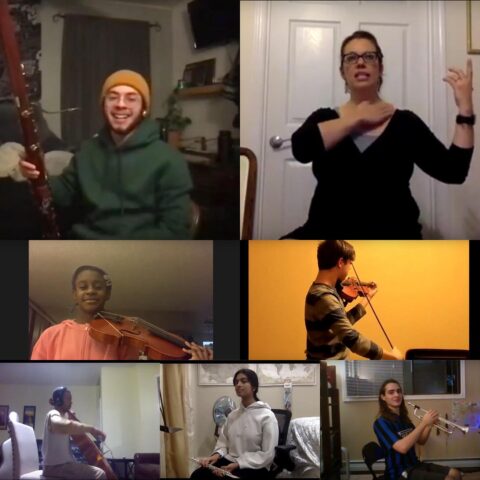In January, the Chicago Musical Pathways Initiative hosted Chicago-based Alexander Technique teacher and flutist, Jill Burlingame. Burlingame came highly recommended by one of CMPI’s partner organizations, The Chicago Youth Symphony Orchestra. CMPI hosted two sessions online for our students. The first was geared toward winds and brass and the second for strings.

CMPI Fellows during a recent Alexander Technique masterclass, via Zoom.
What is the Alexander Technique?
The Alexander Technique teaches you how to change your movement and postural habits, which can improve your mobility, performance, and alertness, and relieve chronic stiffness, tension, and stress. This 100-year old educational method is recognized worldwide for improving freedom and ease in posture, coordination, and breathing. – Chicago Alexander Technique Teachers, website
Burlingame provided the fellows with basic background information about Alexander Technique and simple mindfulness exercises they could engage in to promote a healthier posture and way of being with their instrument. Three wind players and three string players had the opportunity to work with Burlingame over Zoom.
While working with CMPI cellist Kailie Holliday, Burlingame wanted her to think of extending the neck and opening the throat. She asked Kailie to “imagine there’s a really delicious brownies on the ceiling and you just want to reach for it.”
“You should be happy when you discover a habit,” said Burlingame, “because it’s the first step towards changing it.” CMPI fellows Sameer Agrawal and Anika Veda recently shared with me how the exposure to Alexander Technique has impacted their practice habits.
During the Alexander Technique class, there were a few things that really resonated with me, especially regarding my physical balance and posture. I had not really ever noticed that I was leaning to the left and putting more weight in my left leg, and I have found that balancing my weight more can be more effective and healthy. In addition, Ms. Burlingame helped me fix my posture a little bit, regarding my back being kind of curved when I played. During my own individual practice, I definitely have been more cognizant about these habits and trying to play more comfortably and ergonomically. I think that in the future, I will be looking into Alexander Technique to fix any problems I have or just to improve my playing in general.
— CMPI Violin Fellow Sameer Agrawal, sophomore
When I play, I hold a lot of tension in my body, and doing Alexander Technique has helped a lot with that. After the group session with Jill, I decided to try individual lessons to dive even deeper. During our first lesson, Jill pointed out that too much of the flute’s weight was resting on my pinky, instead of the natural pressure points, and gave me exercises to help with that. This helped me gain awareness of why my pinky was always tense, and I tried to be as aware of my hand position as possible when doing things like my long tones and scales. Being more aware of where my tension issues stem from has helped me address them more effectively. I am very interested in continuing to pursue Alexander Technique, as it has only helped me so far!
— CMPI Flute Fellow Anika Veda, junior
